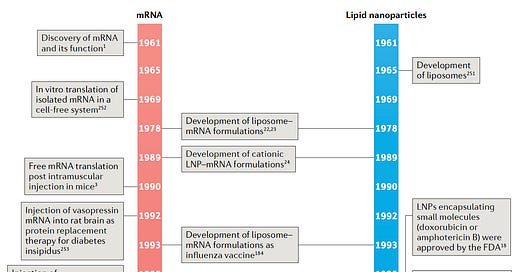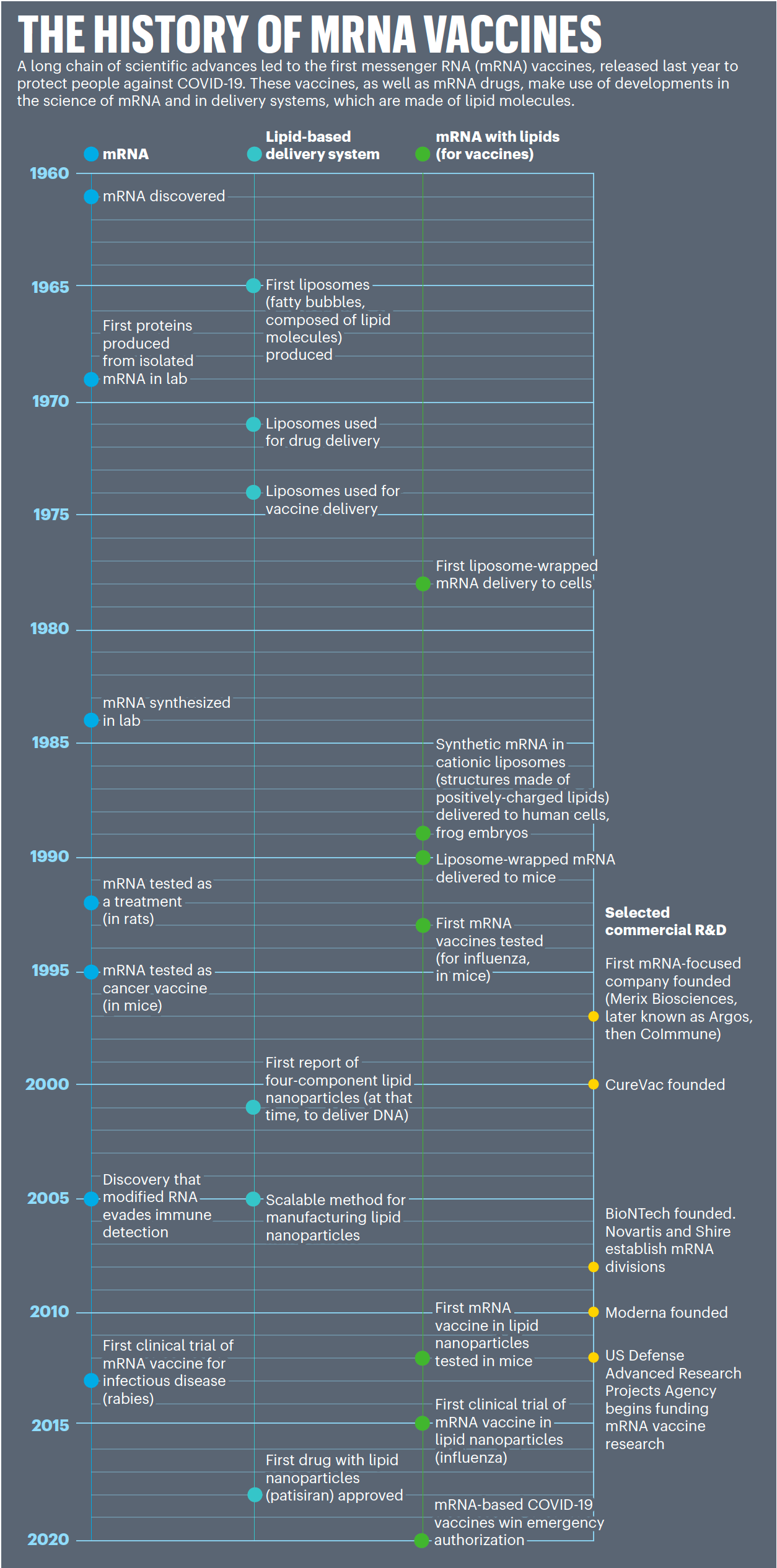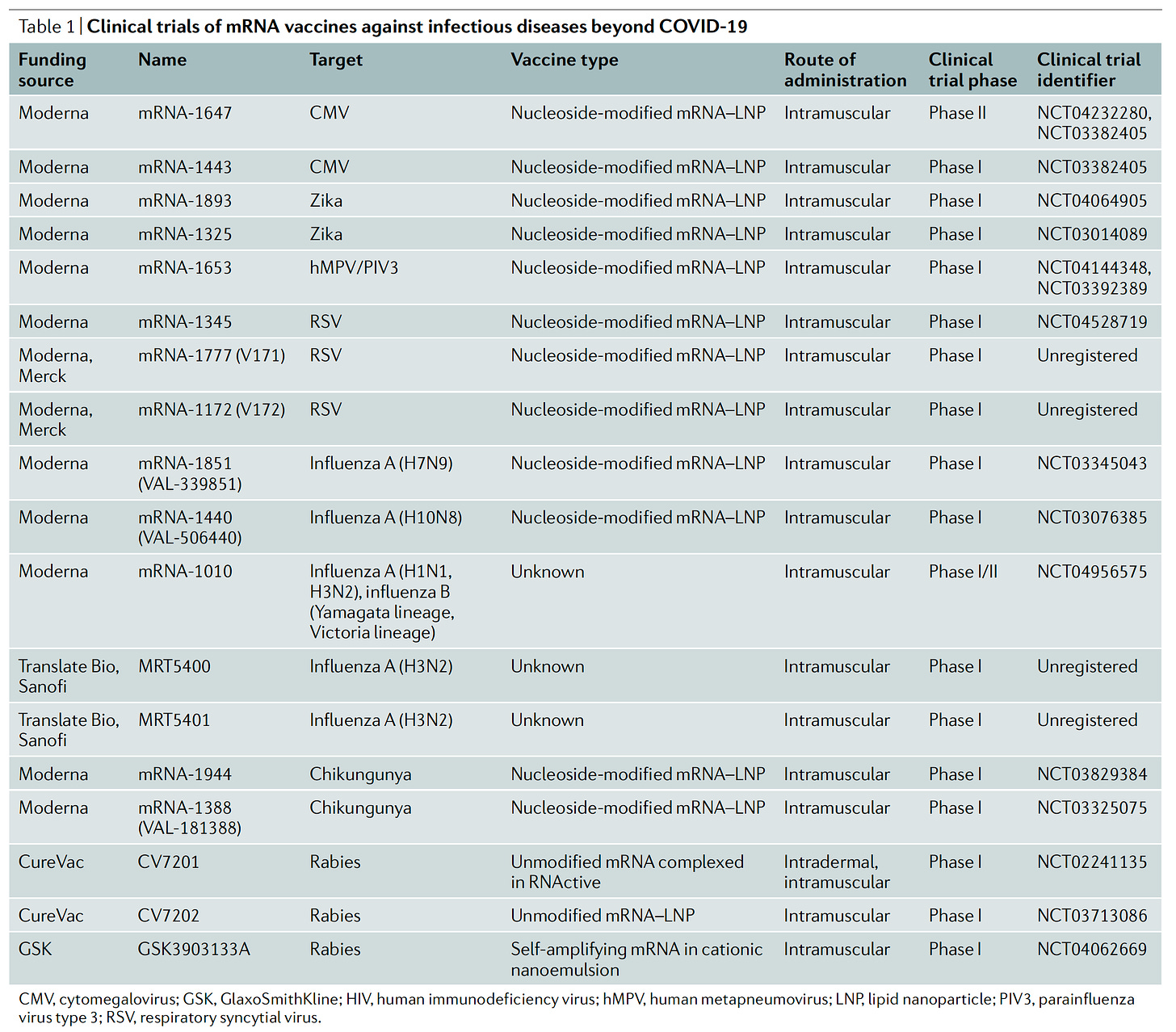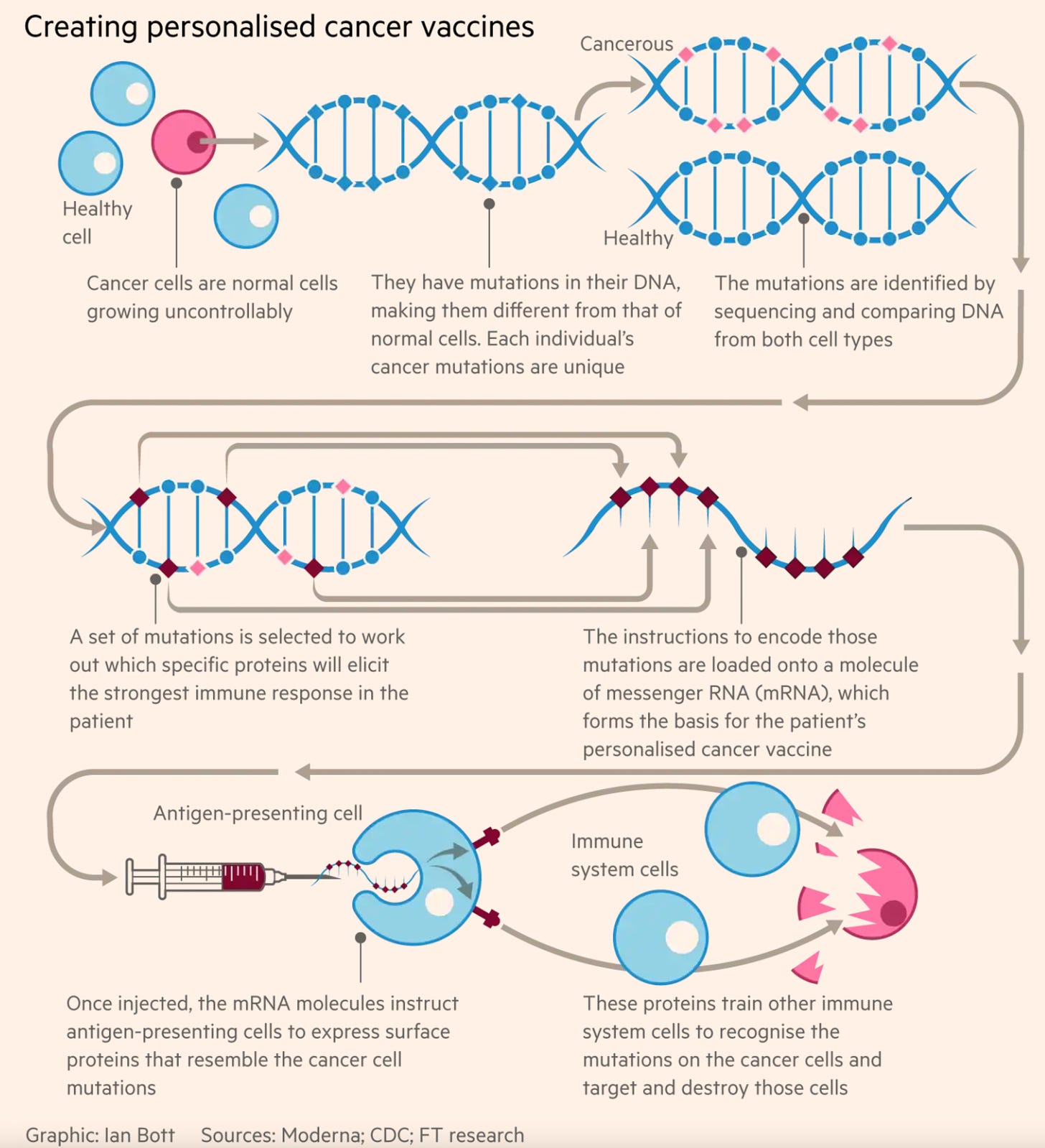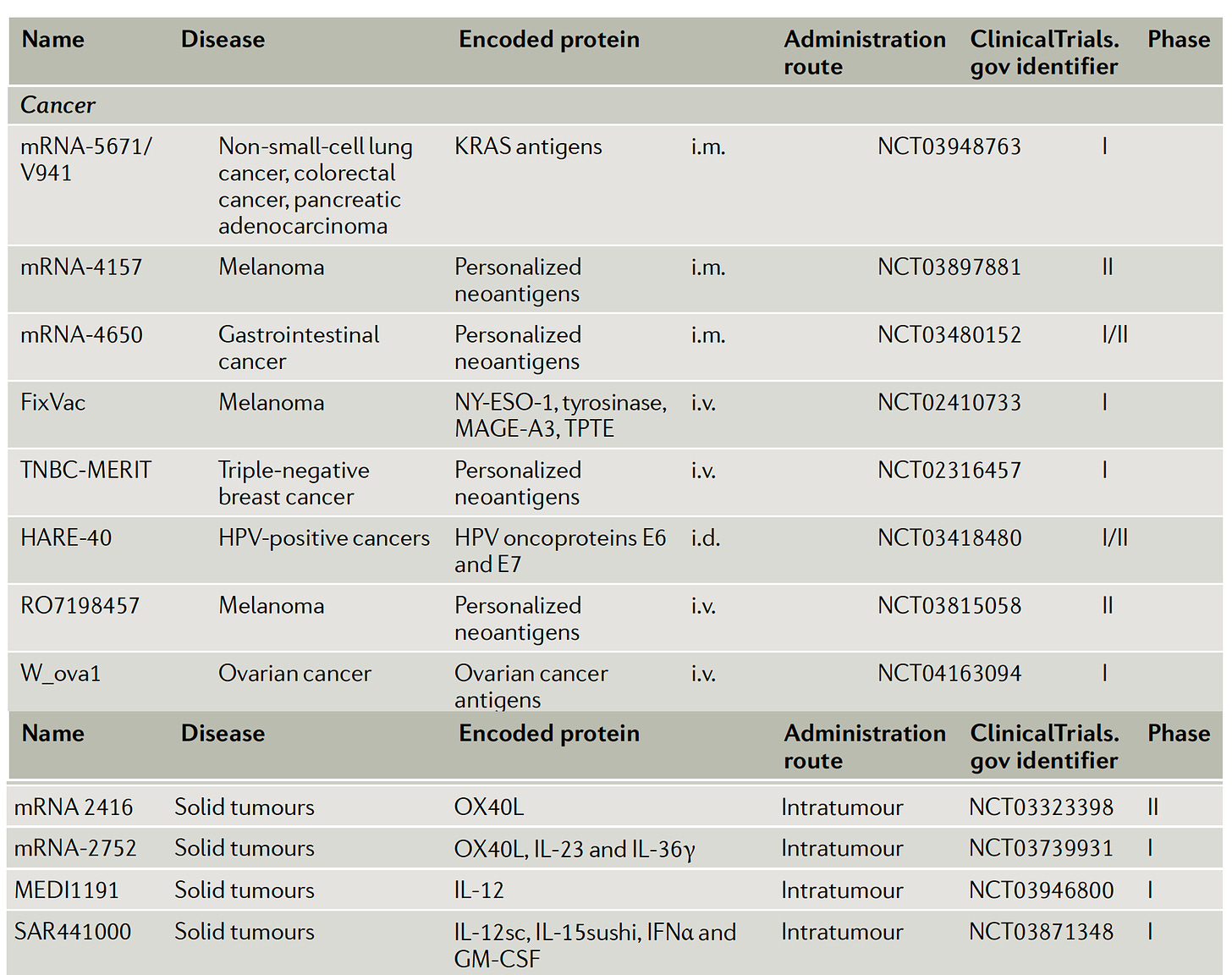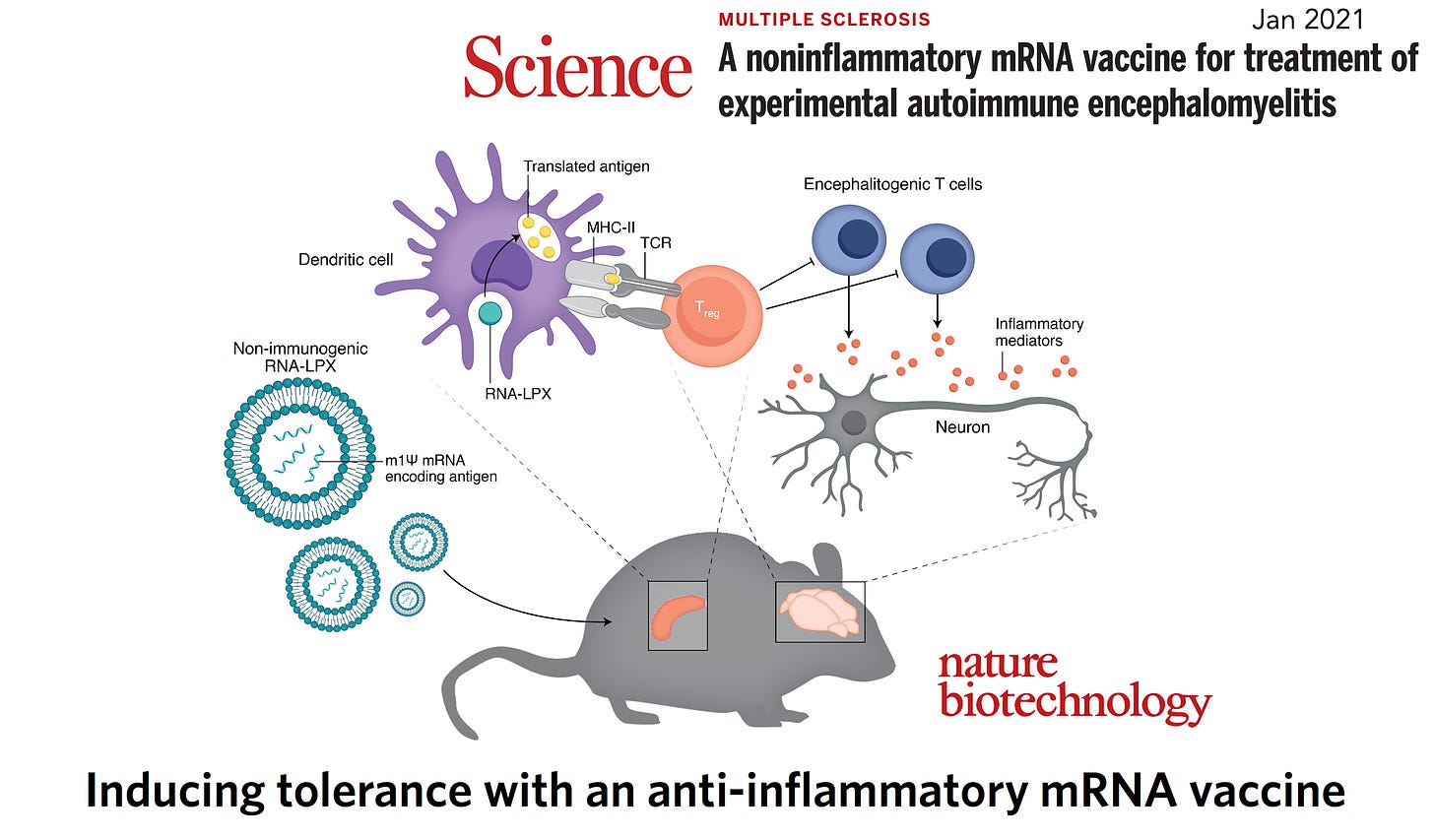The bright side of the Covid pandemic
Validation of a platform with pluripotent potential
Well into its third year, with the loss of lives of millions, and an order of magnitude more sickened with Long Covid, it is hard to envision any positives that emanate from this pandemic. But there is one big one that will transform our ability to prevent and treat a wide variety of diseases for decades to come.
Prior to Covid-19, the combination of mRNA and nanoparticles had never been administered at scale, but now well over 2 billion doses have been given in over 170 countries throughout the world. The mRNA and nanoparticle story, both independently, in parallel, and converged, had been building over many decades, beginning in the 1960’s, but only began early clinical trials around 2015, as summarized in the 2 timelines below
A now classic paper published in the journal Immunity in 2005, was a turning point in the design and delivery of mRNA, as I recently contextualized:
“The path to mRNA vaccines took decades, beginning with Katalin Karikó’s seminal work in the 1990s that was aimed at the major pitfall: avoiding the massive inflammation induced by mRNAs injected into mice. Together with Drew Weissman and colleagues at UPenn, in Immunity in 2005, she determined that this inflammatory response was due to Toll-like receptors and could largely be preempted by modifying an mRNA nucleotide from uridine to pseudouridine. This finding, along with lipid nanoparticles, served as the backbone for the successful mRNA COVID-19 vaccines that achieved 95% efficacy against symptomatic infections in the pivotal Moderna and Pfizer-BioNTech large-scale trials, and over a billion doses have been administered worldwide. The FDA approved an mRNA vaccine for Ebola in 2019, and multiple other pathogens are now being targeted in clinical trials, including HIV, cytomegalovirus, rabies, RSV, influenza A, and chikungunya. In addition, an mRNA vaccine against the malaria parasite Plasmodium has been tested in non-human primates. mRNA therapeutics are expanding well beyond infectious diseases, including revving up the immune response to various types of cancer and neurodegenerative diseases. Furthermore, there is potential for downregulating the immune response to autoimmune conditions and fostering growth of new blood vessels for cardiovascular indications. What begin as a replacement for a uridine base to squash an inflammatory response in mice evolved into the basis for a broad therapeutic platform to fight both communicable and non-communicable diseases in people.”
Few biologics, if any, have been given to more than a billion people with demonstration of such high levels of safety and efficacy. As you might expect, the mRNA + nanoparticle combination, with its first FDA approval in 2019, got momentum to be tested in a number of infectious diseases beyond SARS-CoV-2. More recently mRNA + nanoparticle vaccination elicited tick resistance and prevented B. burgforferi infection, the agent of Lyme disease, in an experimental model. Also, noteworthy, is the potential multivalent mRNA + nanoparticle vaccines to protect against multiple infectious disease at once, such as Covid, influenza and RSV in clinical trials. No less, the mRNA/nanoparticle package will be the foundation for the pan-sarbeocovirus and and pan-β-coronavirus vaccines in development.
Here is a recent tabular summary of their progress in clinical trials
But this narrative is so much bigger than a new and potentially potent approach to many infectious diseases. The basic premise of inducing immunity to a target, as represented here, of course applies to cancer, as we’ve seen marked success of immunotherapy directed at specific forms of cancer in recent years.
Here’s a useful schematic for how cancer vaccines can work
Many cancer vaccine clinical trials are now ongoing, whereby the vaccine is given by a shot (intramuscular), like Covid vaccines, or intravenously, or directly into the tumor. Similarly, with genetic disorders in which a protein antigen target can be identified, multiple clinical trials have been initiated in such conditions as cystic fibrosis, ornithine transcarbamylase deficiency, and transthyretin amyloidosis.
But there is also a flip-side to this premise, what is known as tolerogenic vaccines, with just the opposite effect, which has been demonstrated in an experimental model of multiple sclerosis. This, as described “tailoring the treatment for the disease-causing antigens of individual patients is conceivable, similar to that which has been successfully executed in the setting of personalized cancer vaccines” has major implications well beyond multiple sclerosis, across all the autoimmune diseases that include Type 1 diabetes, rheumatoid and psoriatic arthritis, systemic sclerosis, systemic lupus erythematosus, and several more. Perhaps the most important breakthrough in life science this year was the cause and effect relationship of the Epstein-Barr virus (EBV) for some people with multiple sclerosis, such that mRNA + nanoparticles have 2 new “shots” or paths: a tolerogenic vaccine or one directed to EBV.
If new approaches to various infectious diseases, genetic disorders, cancer, and autoimmune diseases are not enough, there’s the ability to target T cells and inhibit scarring (fibrosis) and restore function of the heart in an experimental model of heart injury. There’s no reason that preventing or reducing such scarring/fibrosis of other organs, which has been an elusive goal of therapies for many decades, would be potentially susceptible to this strategy in the future.
Or to improve and expand efforts to achieve genome editing or gene therapy, that were previously confined to disorders of the blood, such as sickle cell disease, or the eye, like Leber’s congenital amaurosis, can be expanded to the liver, not just for particular storage disorders, but for lowering LDL cholesterol to prevent heart attacks.
It’s important to recognize than both the mRNA and nanoparticle side of the combo have major refinements in store. Each of the 4 components of lipid nanoparticles can and will be improved, with enhanced efficiency of delivery and safety. If you’d like to get into more depth on this, here is an excellent review paper.
There is potential for marked expansion in modes of organ and cell-specific delivery, as shown below:
That is paralleled by the anticipated improvements in the mRNA component, which includes the use of self-amplifying RNA (already being used in a rabies clinical trial, seee table above), circular RNA, and long non-coding RNA al of which have potential to improve mRNA’s stability, half-life, and achieve more efficient sub-cellular localization. Recall that Karikó and Weissman modified mRNA (uridine to pseudouridine) that set the foundation for the whole field, and there are so many more ways to further modify mRNA that lie ahead, including powerful editing tools that are now available, that may prove to be equally transformative.
Earlier this year, Helen Branswell, a noted science journalist, wrote “Why Covid-19 vaccines are a freaking miracle”. Yes, they have been a miracle (their loss of potency of protection over time has stemmed from the virus’s accelerated evolution, as I previously reviewed) that took many decades in incubation but are now poised to make an enormous difference for many decades to come. The sheer breadth of disorders with a potential new, fresh approach, many of which have heretofore had no means of therapy or prevention, is staggering. We’ll look back at the pandemic someday as an extraordinary renaissance in biomedicine, giving rise to a validated pluripotent platform with seemingly unlimited refinements and applications.

